Back to Journals » Journal of Blood Medicine » Volume 11
Practice of Blood Donation and Associated Factors among Adults of Gondar City, Northwest Ethiopia: Bayesian Analysis Approach
Received 25 September 2020
Accepted for publication 14 December 2020
Published 30 December 2020 Volume 2020:11 Pages 525—532
DOI https://doi.org/10.2147/JBM.S283991
Checked for plagiarism Yes
Review by Single anonymous peer review
Peer reviewer comments 2
Editor who approved publication: Dr Martin H Bluth
This paper has been retracted.
Ayenew Kassie, 1 Setognal Birara 2
1Department of Health Education and Behavioral Health, Institute of Public Health, College of Medicine and Health Sciences, University of Gondar, Gondar, Ethiopia; 2Department of Public Health, College of Medicine and Health Sciences, Samara University, Samara, Ethiopia
Correspondence: Ayenew Kassie Tel +251-93-178-9238
Email [email protected]
Background: Blood transfusion is an essential part of modern health care. In Ethiopia, it had been planned to collect 202,000 units of blood in 2016– 2017, but the actual amount collected was 169,744. The Bayesian approach has an advantage in that estimation of model parameters is conducted based on posterior distribution. This study aimed to assess the practice of blood donation and associated factors among adults of Gondar city, northwest Ethiopia using Bayesian analysis.
Methods: A community-based cross-sectional study was conducted among 554 Gondar adults from February to March 2019. Bayesian binary logistic regression was conducted to assess the relationship between independent and dependent variables using Stata 15 with a 95% CI for statistical significance.
Results: A total of 515 were involved with a 97% response rate, among which 342 (66.4%) were females. Eighty (15.53%) had donated blood at least once in their lives. Men were more likely to donate blood (AOR 1.79, 95% CI 1.11– 3.12), while those aged 18– 24 years were 57% (AOR 0.43, 95% CI 0.15– 0.89) less likely to give blood. Individuals with good knowledge (AOR 2.56, 95% CI 1.32– 4.53) and favorable attitudes (AOR 1.86, 95% CI 1.01– 3.06) were more likely to donate blood.
Conclusion: The majority of the participants did not donate blood. Male sex, age 18– 24 years, good knowledge, and favorable attitudes were statistically significant factors in blood donation. Intervention with females and younger age-groups should shall be better administered. Health education is required to increase knowledge and create a favorable attitudes among the community.
Keywords: practice, blood donation, Bayesian logistic regression, Gondar city
Background
Blood transfusion is an essential part of modern health care. It can save lives and improve health.1 Blood transfusion is needed for patients with severe anemia, sickle-cell disease, bleeding disorders, eg, hemophilia, or cancer.2 Blood transfusion and component therapies are an integral part of modern medical interventions. However, these therapies are not risk-free, with risk ranging from potentially fatal immunohypersensitivity reactions to potential transmission of blood-borne pathogens from donor to recipient.3 Most of the blood used for transfusions comes from whole-blood donations given by volunteer blood donors. A person can also have his or her own blood collected and stored a few weeks before surgery in case it is needed.1
The availability of safe blood is a critical component in improving health care and preventing the transmission of infections. While blood provision and safety are often taken for granted in the industrialized world, the quality and safety of blood transfusion remain continuing concerns in developing countries, in which 82% of the world’s population lives.4
Globally, more than 530,000 women die each year during pregnancy, childbirth, or the postpartum period, and 99% of these are in the developing world. Severe bleeding during or after childbirth is commonest cause of maternal mortality, contributing up to 44% of maternal deaths in Africa, 31% in Asia, and 21% in Latin America and the Caribbean.2 In 2013, maternal hemorrhage was one of the leading causes of maternal death, constituting >13% of deaths in Ethiopia.5
In developing regions, maternal and neonatal mortality were responsible for 3 million deaths in 2013 and are important contributors to overall global mortality.6 It has been further estimated that 90,000 deaths in both sexes and all age-groups are due to iron-deficiency anemia alone.7 Blood supplies in Africa have never been able to meet demand. This is reflected in the high maternal- and child-mortality rates in the continent.4 The average blood-donation rate in Africa is 4.7 units/1,000 inhabitants. The Ethiopian National Blood Bank collects nearly 200,000 units of blood from donors annually, but the country requires 18,000 units of blood daily and the average daily amount collected is approximately 1,100 units, a shortfall of 7,943 L.8 According to the 2015–2016 Ethiopian Health Sector Transformation Plan report, 84 0.03% unit of blood was collected.9 In classical statistics, analysis of logistic regression is based on estimating parameters through maximum-likelihood estimation (MLE), and given the asymptotic properties, MLE in small samples encounters serious inferential problems. In such a case, the Bayesian approach has an advantage in that estimation of model parameters is conducted on the basis of posterior distribution, which is the combination of observed data and information from previous studies or personal experiences, known as prior distribution.10 This study aimed to assess practices of blood donation and associated factors among adults of Gondar city, northwest Ethiopia, with Bayesian analysis to fill information gaps.
Methods
Study Design and Study Area
The community-based cross-sectional study was conducted from February 28 to March 30, 2019 among adults of Gondar to assess practices of blood donation. Gondar is 727 km from Addis Ababa, the capital of Ethiopia, and 180 km from Bahir Dar, the capital of Amhara Regional State. Gondar has a total area of 192.3 km2.
Study Population and Sampling
All adults aged 18–65 years and residents of Gondar city were included. Critically ill individuals unable to give information were excluded. The sample size was calculated using a single-population proportion for the outcome variable and double-population proportion for factors. The final sample size was 554. To begin with, two subcities were randomly selected from six subcities using simple random sampling. Next, systematic sampling was employed to select households from each subcity. Interval values were calculated fby dividing the total number of households of each selected subcity by its proportional sample size. The initial household to be interviewed was selected randomly by lottery.
Study Variables
The dependent variable was blood-donation practices, and independent variables were sociodemographic (age, sex, marital status, education, occupation, religion, monthly income, and ethnicity), knowledge of, attitudes toward, and barriers to blood donation.
Data Processing and Analysis
Data were collected with a pretested structured validated World Health Organization voluntary blood–donation questionnaire and other relevant literature.11,12
The questionnaire was initially prepared in English, translated into Amharic (local language), then retranslated back to English to check for any inconsistencies or distortions in the meaning of words and concepts. Pretesting was done on 5% of the total sample. Necessary amendments were made upon identification of ambiguity. Trained data collectors, supervisors, and the investigator checked and reviewed completed questionnaires daily.
Data Analysis
Data were entered into EpiData version 3.0 and transferred to Stata version 15 for analysis. Data were coded and cleaned for completeness and consistency. Descriptive analysis was done to observe frequency distribution.
Bayesian Binary Logistic Regression Model
The dependent variable (Yi)was dichotomous: 1 for adults who donated blood and 0 for those who did not.A binary logistic regression model with Bayesian approach was adopted to examine the effect of the predictors on the response variable — blood donation.
For the binary response variable (Y), binary logistic regression model with logit-link function has the form:
where piis the probability of the ith adult donating blood, Yi observed of blood donation status(yes/no) for the ith adult, X1, X2 . . . Xp independent variables and β = T (β0, β1. . . βp) are vectors of unknown binary logistic regression parameters.
In a classical approach, analysis of a logistic regression model is based on estimating parameters of the model through MLE and calculating an estimate using the expectation-maximization algorithm. With this method, it is possible to evaluate the local maximum instead of the general MLE without calculating the convergence of the model. Furthermore, given asymptotic properties, MLE in small samples encounters serious inferential problems. However, in the Bayesian method, inference about model parameters is conducted on the basis of posterior distribution, which is the combination of the likelihood function of observed data and information from previous studies or personal experiences, known as prior distribution.14
This approach was applied to a binary logistic regression model, taking account of uncertainty in the parameters, to identify the determinants of blood donation in Gondar. Furthermore, the idea of Bayesian statistics within the context of life-data analysis is to integrate prior knowledge, along with a given set of current observations, to make statistical inferences. The advantages of Bayesian inference are well known, and include elicitation of prior beliefs about experiences, avoidance of asymptotic approximations, and practical estimation of functions of parameters.13,14
Bayesian inference assumes that the data are fixed and considers all unknown parameters as random variables.15 This method also allows detailed inference from parameters and can be obtained for any arbitrary sample size. To progress with Bayesian analysis, it is necessary to provide a likelihood function for the data and joint prior distribution over the parameter space. As such, for data from individual subjects that are assumed to be independent of one another, the likelihood function (Y = [y1, y2 . . . yn])T over a data set for n subjects, the likelihood function for data is:
Moreover, one of the preconditions in any Bayesian analysis is the prior choice,and the most common prior choice for logistic regression parameters is a normal distribution with mean μj and variance σ2. This has the form:
Mathematically, the prior distribution for logistic regression parameters has the form:
The most common choice for prior mean μj is 0 for all coefficients and large-enough prior variance σ2j. As such, in this paper, due to the lack of information for prior distribution of regression coefficients, noninformative normal prior distribution with prior-distribution parameters of mean 0 and variance 1,000 was considered. Then, for the choice of noninformative independent normal priors and likelihood function for the data, posterior distribution of model parameters, which is the product of equations 2 and 3, has the form:
Clearly, this posterior distribution is a complex function of the parameters, and numerical methods are needed to obtain the marginal posterior distribution for each of the model parameters. The most popular method is simulation from a general posterior distribution using Markov chain Monte Carlo (MCMC) simulation.16 Therefore, in this study MCMC simulation with Metropolis–Hastings sampling was used for samples from the posterior distribution and implemented on Stata 15. The empirical results from a given MCMC analysis are not deemed reliable until the chain has reached a stationary distribution. On account of this, the term convergence of an MCMC algorithm refers to whether the algorithm has reached its target distribution. Therefore, monitoring the convergence of the algorithm is essential for producing results from the posterior distribution of interest.17 Among several methods, the most popular and straightforward convergence-assessment — time series (history) plots, density plots, Monte Carlo SE, and Gelman–Rubin statistic15 — were used to assess whether the sample had reached stationary distribution or not. Summary statistics (posterior mean, SE of posterior mean, OR of posterior mean, and CI of posterior mean) were computed for each parameter. Finally, the importance of each of the explanatory variables is assessed by carrying out statistical tests of the significance of the regression coefficients (posterior mean) via 95% Bayesian CI of the posterior mean.18
Results
Sociodemographic Characteristics
A total of 515 participants were involved in the study with 97% response rate and 342 (66.4%) were women. A majority of the participants, 237, 46.02%) were married, and 228 (44.27%) had attended institutions following secondary school (Table 1).
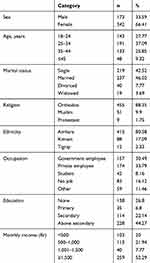 |
Table 1 Sociodemographic Characteristics of Gondar City Adults |
Knowledge of Blood Donation
Of total participants, 237 (46.02%) had good knowledge about blood donation. More than half (286, 55.5%) were correct regarding the age-range for blood donation. Participants were asked about the amount of blood an individual could donate each time, and 137 (26.6%) answered correctly, while only 128 (24.7%) were correct about the period for which blood stayed stored. A total of 279 (54.17%) reported that an individual was able to give blood every 3 months. A majority (417, 81%) reported blood was needed for patients with severe anemia (Table 2).
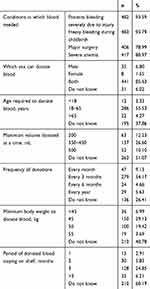 |
Table 2 Knowledge of Adults on the Practice of Blood Donation and Associated Factors in Gondar City |
Attitudes Toward Blood Donation
In sum, 205 (39.8%) participants had favorable attitudes toward blood donation. More than half (288, 55.7%) agreed that blood donation gave satisfaction to the donor, and 83 (16.12%) thought that blood donation could affect the health of the donor. Most participants agreed that by donating blood, it was possible to decrease deaths of mothers (62.33%) and children (62.14%). Blood donation was a pleasant activity for most (339, 65.83%), as shown in Table 3.
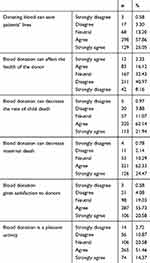 |
Table 3 Attitude of Adults Toward the Practice of Blood Donation and Associated Factors in Gondar city |
Blood-Donation Practices
Gondar blood donors numbered 80 (15.53%, 95% CI 13%–19%). Of these 38 (7.38%) had donated once, 33 (6.41%) twice, and nine (1.75%) thrice and above. Respondents who did not donate blood mentioned different reasons. About 110 (25.29%) did not donate due to fear of needle pain, 55 (12.64%) having health problems, and 228 (52.41%) did not have adequate information about where and when blood is donated, among other reasons (Figure 1).
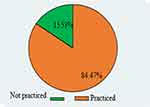 |
Figure 1 Practice of blood donation among of Gondar city adults, northwest Ethiopia, 2019. |
Bayesian Logistic Regression Analysis
Bayesian logistic analysis was used to make an inference about the parameters of the logistic regression model. The Metropolis–Hastings algorithm was implemented with 116,000 iterations and 6,000 burn-in terms discarded, so 111,000 samples were generated from the full posterior distribution. We used normal priors with large variance (mean 0, variance 106) for regression parameters. Before undertaking any inference from the posterior distribution, the convergence generated from Markov chains was verified by convergence-assessment plots (Annex 1).
Attitudes, sex, and age were statistically significant determinants of blood donation with 95% CIs (Table 4).
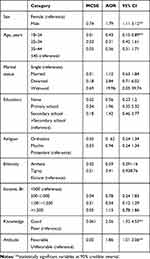 |
Table 4 Multivariate Bayesian Logistic Regression of Blood-donation Practices Among Gondar adults |
Keeping other variables constant, individuals with good knowledge increased odds of blood donation by 2.56 times over those with poor knowledge (AOR 2.56, 95% CI 1.32–4.53).
After adjustment for other covariates, individuals with favorable attitudes increased the odds of blood donation by 1.86 times over those with unfavorable attitudes (AOR 1.86, 95% CI 1.01–3.06).
Holding other covariates constant, the odds of blood donation decreased by 57% in respondents aged 18–24 years old compared to those aged >45 years (AOR 0.43, 95% CI 0.15–0.89).
After adjustment for other covariates, male sex were increased the odds of blood donation by 1.79 times over female sex (AOR 1.79, 95% CI 1.11–3.12).
Discussion
This study aimed to investigate the relationship between blood-donation practices of adults and sociodemographic variables, knowledge, and attitudes in Gondar using Bayesian analysis. According to this study, knowledge, attitudes, age, and sex of participants were statistically significant variables, with 95% Bayesian CIs.
The proportion of blood donors in this study was 15.5%. This is comparable with studies conducted in Debre Markos (16.1%) and another in Gondar (18.4%),15,18 but slightly lower than studies conducted in Mizan Aman, southwest Ethiopia (26.4%) and Harer (22.6%).19,20 It is believed that educated individuals are more likely to donate blood. As such, the proportion of literate participants in our study was lower than the aforementioned studies. Furthermore, knowledge of blood donation is related to giving blood, and the knowledge of our study participants was lower than previous research.21 These could be the possible reasons for the variation inblood-donation practices.
Men were 1.79 times more likely to donate blood than women. This result is supported by studies conducted in Eboni (Nigeria), Karachi, Harer, Addis Ababa, and Gondar.18,20–23 A possible explanation could be that women defer blood donation in part because of higher anemia due to menstruation, lactation, or other health-related problems.24
On the other hand, age was significantly associated with blood donation. Those aged 18–24 years were 57% less likely to donate blood than those aged >45 years. This finding is comparable with other studies.15,25 It might be that older adults are concerned about other individuals because most have spouses and children, so believe that donating blood might save their famiy’s life. Younger participants might be single and not bother about others’ health conditions.
The results of the current study revealed that those with good knowledge were 2.56 times more likely to donate blood those with poor knowledge. This result is consistent with studies in Tigray, northern Ethiopia, Gondar University Hospital, and Tanzania.24,26,27 Having more knowledge about the importance of donations drives adults to donate blood.
The other factor significantly associated with blood donation in our study was attitudes. Respondents with favorable attitudes were 1.86 times as likely to donate blood than those with unfavorable attitudes. This finding is consistent with prior research.24,26–28 An explanation could be that that if an individual feels that donating blood could decrease deaths of children and mothers, this gives satisfaction and believes had no problem on his/her health to the future s/he engage in blood donation.
Study Limitation
We did not assess reasons behind deferral among nondonors, so did not separate factors among donors and nondonors.
Conclusion
A minority of participants donated bloodn. Male sex, age 18–24 years, good knowledge, and favorable attitudes weresignificantly associated with blood donation. Therefore, interventions should target females and younger age-groups. Because the knowledge of these participants was less than their counterpart, health education is required to increase knowledge and create favorable attitudes in the community.
Abbreviations
MCMC, Markov Chain Monte Carlo; MCSE, Monte Carlo standard error; MLE, maximum likelihood estimation.
Availability of Data and Material
The data sets generated and/or analyzed during the current study are available at the University of Gondar, College of Medicine and Health Science, Institute of Public Health, and Gondar City Health Department in hard and soft copy (www.UoG.edu.et). They are also available from the authors upon reasonable request and with permission of the principal investigators (Ayenew Kassie — [email protected]).
Ethics Approval and Consent to Participate
Ethics approval for the study was obtained from the Institutional Review Board of the University of Gondar (IPH/180/2/2019). An official letter explaining the objectives of the study was sent to the Gondar City Health Department. The department wrote back, suggestin studying subcities as well. The objectives and benefits of the study were explained to subjects. Oral consent was obtained from each participant. The right of participants to withdraw from the study whenever they wanted was respected. An anonymous questionnaire was used to protect the identity and confidentiality of information obtained from participants.
Consent for Publication
This was not required, because our manuscript does not contain data from any person in the form of any individual details, images, or videos.
Acknowledgments
We would like to forward our heartfelt gratitude to the University of Gondar College of Medicine and Health Sciences Institute of Public Health for providing us financial support, ethics clearance, and assigning adivisorship to do this practical research.
Finally, we would like to acknowledge study participants, data collectors, and supervisors for their time and contribution to this work.
Author Contributions
All authors contributed to data analysis, drafting or revising the article, have agreed on the journal to which the article will be submitted, gave final approval to the version to be published, and agree to be accountable for all aspects of the work.
Funding
The University of Gondar covered the cost of the research.
Disclosure
The authors declare that they have no competing interests.
References
1. and B. I. NHLBI National Heart, Lung, “blood transfusion. Hospital Tranfsusion Committee CHCSJ Heath Bureau. Macau; 2005. [Online]. Available: https://www.nhlbi.nih.gov/health-topics/blood-transfusion.
2. World Health Organization. Dhingra DN. “Estimate blood requirements - search for a global standard. World Health Organization. 2008.
3. Keleta YT, et al. Seroprevalence of transfusion transmitted infections among blood donors in Gash Barka Zonal Blood Transfusion Center, Barentu, Eritrea, 2014 through 2017. BMC Hematol. 2019;19:1–9.
4. Maxime K S. Diane, Bamory, “Blood collection to cover national needs in sub-Saharan africa: the reality of ivory coast”. Blood Transfusion. 2014.
5. Haeri S, Dildy GA. Maternal mortality from hemorrhage. YSPER. 2012;36(1):48–55.
6. Bank TW. Trends in maternal mortality: 1990 to 2013. World Health Organization. 2013.
7. world health Organization. The global prevention of Anemia in 2011. 2015.
8. World Health Organization. current status on blood safety and availability in WHO africa region. 2013.
9. The Federal Democratic Republic of Ethiopia Ministry of Health: Health Sector Transformation Plan HSTP 2015/2016 - 2019/2020.
10. colin Howson and peter and Urbach. Bayesian reasoning in science. 1991 Nat Publ Gr. 1991;350:371–374.
11. World Health Organization and. International federation of red cross and red crescent societies, “towards 100 % voluntary blood donation a global framework for action,”. World Health. 2010;6(123).
12. Mohammadi T, Kheiri S, Sedehi M. Analysis of blood transfusion data using bivariate zero-inflated poisson model: a bayesian approach. Hindawi Publ Corp Comput Math Methods Med. 2016;2016:1–7.
13. Anjullo BB, Haile TT. A bayesian binary logistic regression approach in identifying factors associated with exclusive breastfeeding practices at Arba Minch Town, South Ethiopia. Adv Res. 2018;17(5):1–14.
14. Moore PG. The bayesian approach to statistics. J Inst Actuar. 1966;92(3):326–339.
15. Carlin BBP, Louis TA. Bayesian data analysis By A. Gelman, J. B. Carlin, H. S. Stern, and D. B. Rubin. Am J Epidemiol. 1997;146(4):21–24.
16. Spiegelhalter D, Best N, Way R, Cb C. Bayesian inference using gibbs sampling addendum to manual. In: Bayesian Inference Using Gibbs Sampling. MRC Biostatistics unit, Institute of Public Health, Robinson Way, Cambridge CBS 2SR. 1997:1–18.
17. Merkle AE, Van Zandt T. WinBUGS tutorial outline WinBUGS overview. In: WinBUGS Tutorial Outline. 2005:1–56. Available from: http://mathstat.helsinki.fi/openbugs/.
18. In S. The advantages of bayesian methods over classical methods in the context of credible intervals w. Inf Syst Manag. 2015;4:53–63.
19. Jemberu YA, Esmael A, Ahmed KY. Knowledge, attitude and practice towards blood donation and associated factors among adults in Debre Markos town, Northwest Ethiopia. BMC Hematol. 2016;16:1–8.
20. Melku M, et al. Knowledge, attitude, and practice of adult population towards blood donation in Gondar Town, Northwest Ethiopia: a community based cross-sectional study. J Blood Transfus. 2016;2016:1–10.
21. Enawgaw B, Yalew A, Shiferaw E. Blood donors’ knowledge and attitude towards blood donation at North Gondar district blood bank, Northwest Ethiopia: A cross-sectional study. BMC Res Notes. 2019;12(1):1–6.
22. Mulatu K TB, Hailu T, Yegezu A. iMedPub Journals assesment of knowledge, attitude and practice on blood donation in Aman,”. Heal Sci J. 2017;11:1–6.
23. Urgesa K, Hassen N, Seyoum A. Knowledge, attitude, and practice regarding voluntary blood donation among adult residents of Harar town, Eastern Ethiopia: a community-based study. J Blood Med. 2017;8:13–20.
24. Bani M, Giussani B. Gender differences in giving blood: A review of the literature. Blood Transfus. 2010;8(4):278–287.
25. Ahmed Z, Zafar M, Khan AA, Anjum MU, Siddique MA. Journal of infectious diseases and knowledge, attitude and practices about blood donation among undergraduate Medical Students in Karachi. J Infect Dis Ther. 2014;2(2):2–5.
26. Misganaw C. the level and associated factors of knowledge, attitude and practice of blood donation among health science students of Addis ababa University. Int J Med Heal Sci Res. 2014;1(10):105–118.
27. Ossai EN, Eze NC, Chukwu O, Ugochinyere A. Archives of community medicine and public health determinants of practice of blood donation among undergraduate students of Ebonyi State University. Arch Community Med Public Heal. 2018;4:1–7.
28. Arage G, Ibrahim S, Adimasu E. Blood donation practice and its associated factors among health professionals of University of Gondar Hospital, Northwest Ethiopia: a cross sectional study. BMC Res Notes. 2020;10(2017):1–6.
 © 2020 The Author(s). This work is published and licensed by Dove Medical Press Limited. The full terms of this license are available at https://www.dovepress.com/terms.php and incorporate the Creative Commons Attribution - Non Commercial (unported, v3.0) License.
By accessing the work you hereby accept the Terms. Non-commercial uses of the work are permitted without any further permission from Dove Medical Press Limited, provided the work is properly attributed. For permission for commercial use of this work, please see paragraphs 4.2 and 5 of our Terms.
© 2020 The Author(s). This work is published and licensed by Dove Medical Press Limited. The full terms of this license are available at https://www.dovepress.com/terms.php and incorporate the Creative Commons Attribution - Non Commercial (unported, v3.0) License.
By accessing the work you hereby accept the Terms. Non-commercial uses of the work are permitted without any further permission from Dove Medical Press Limited, provided the work is properly attributed. For permission for commercial use of this work, please see paragraphs 4.2 and 5 of our Terms.






